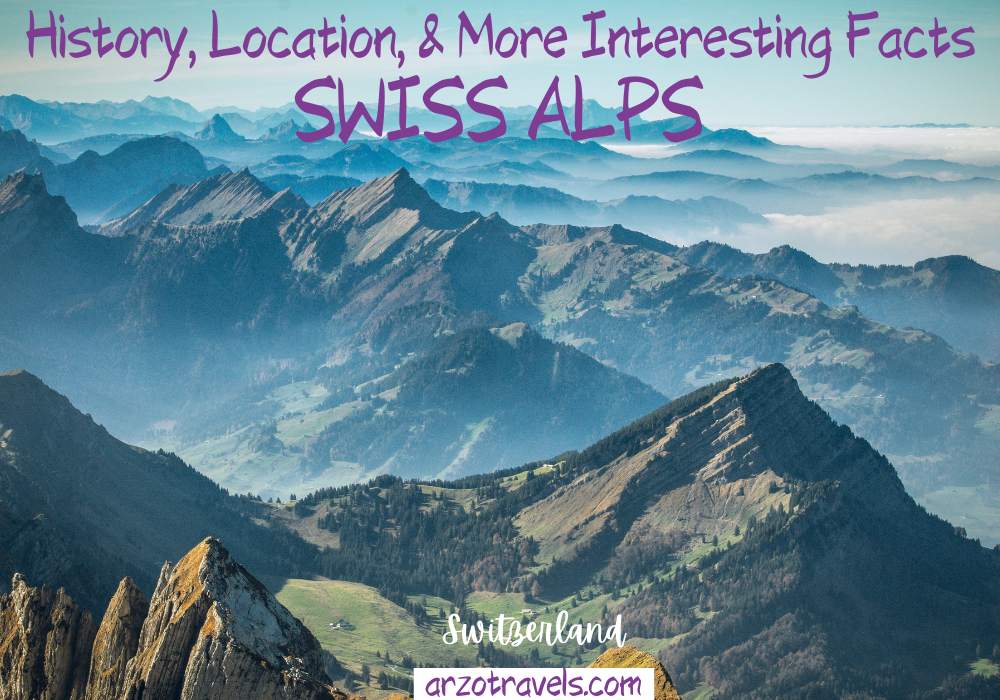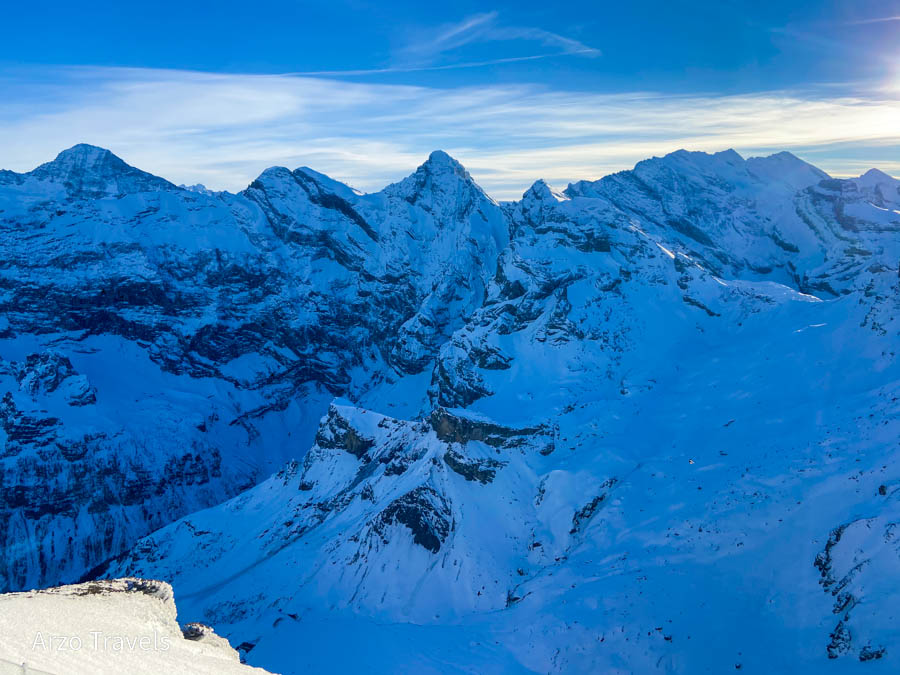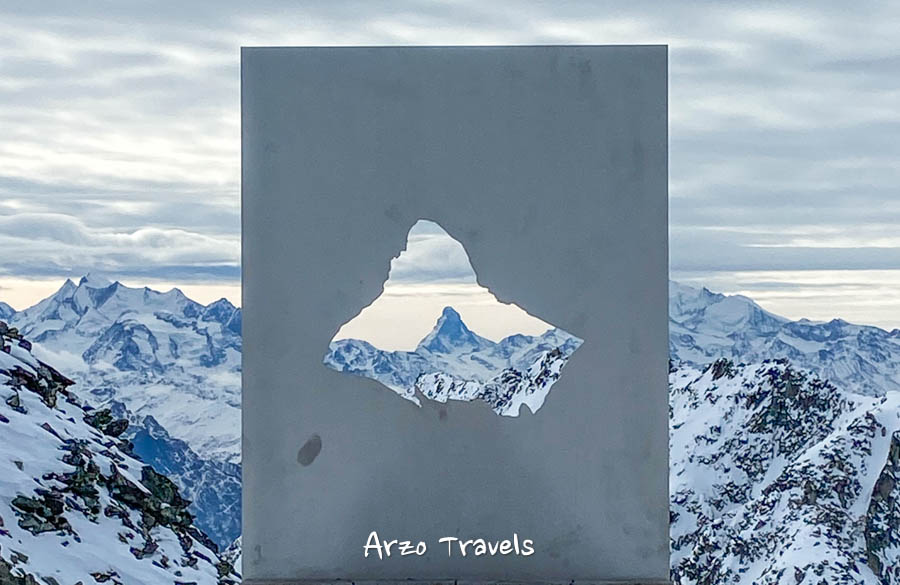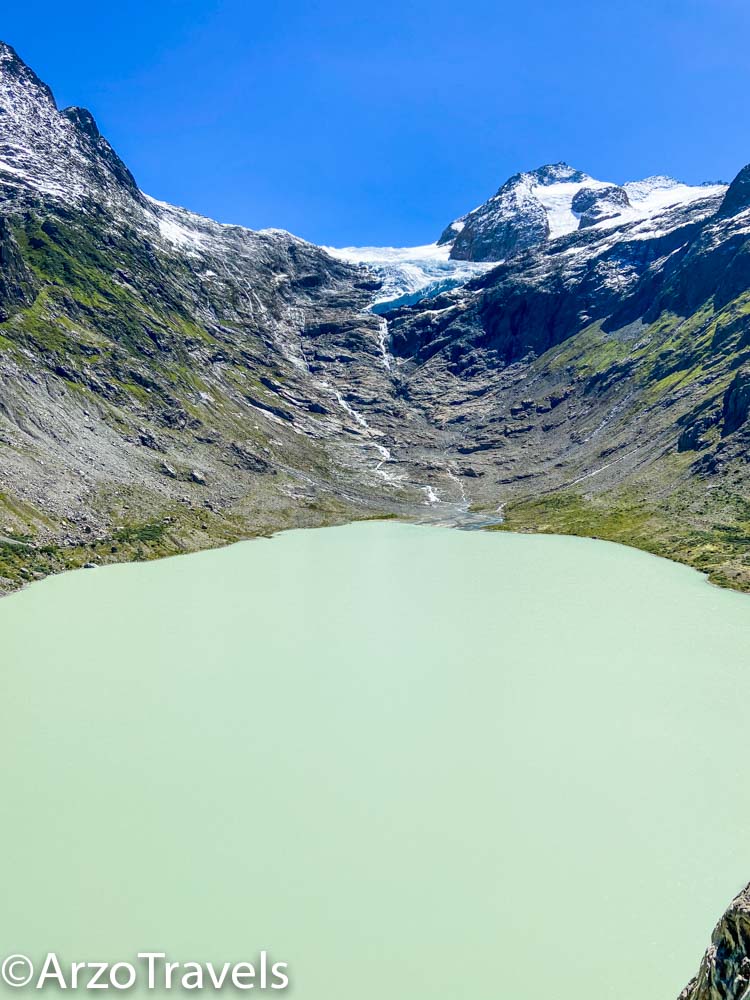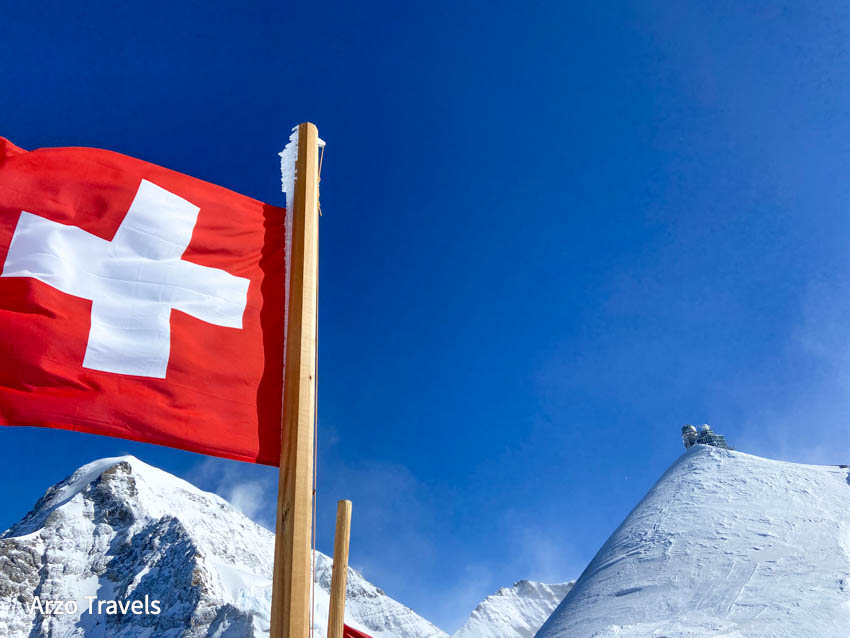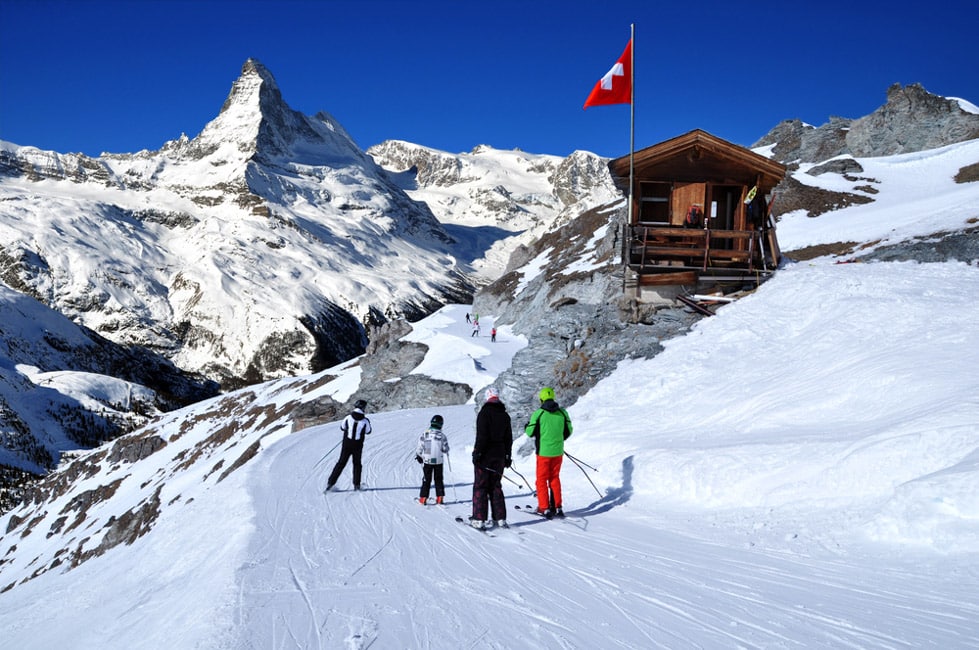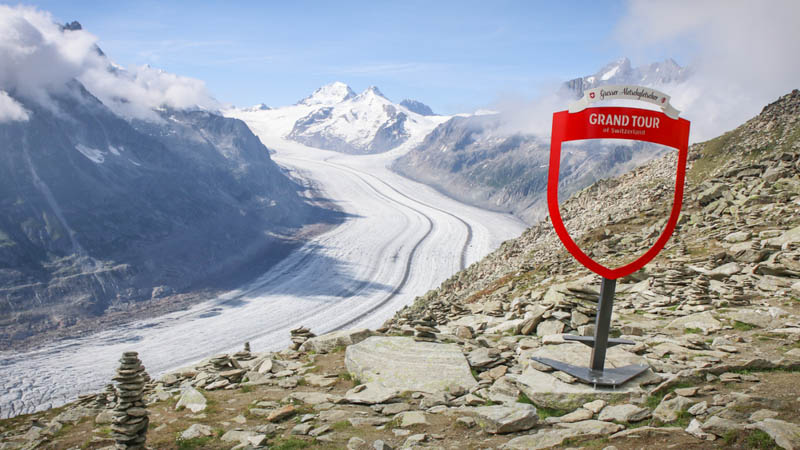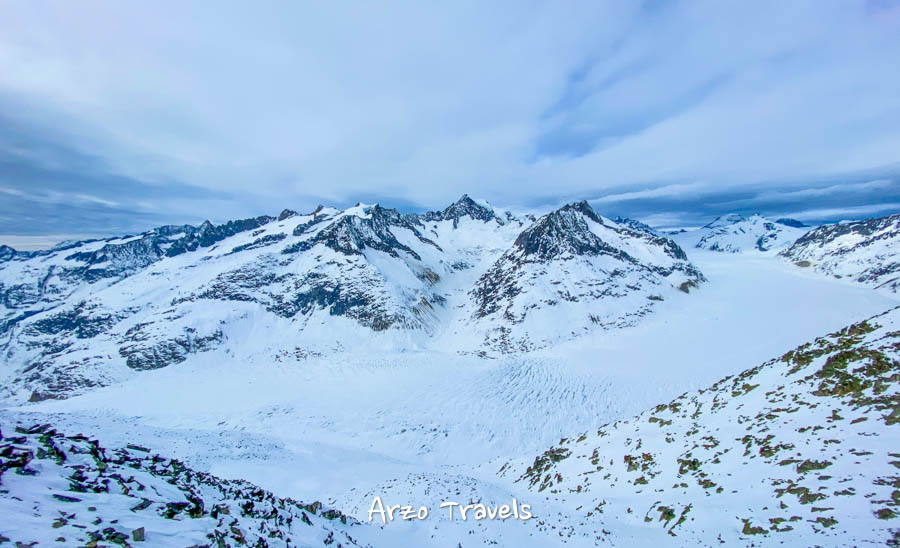WHAT YOU NEED TO KNOW ABOUT THE ALPS IN SWITZERLAND
The Swiss Alps, officially the Alpine region of Switzerland, is a mountainous region in this beautiful country. Globally famous, you’ll find them south of the Swiss Plateau (northern Switzerland), stretching from Lake Geneva to the Swiss-Austrian border.
This region forms part of Europe’s greater Alps Mountain Range and covers approximately 60% of Switzerland’s surface area. The many peaks in the Swiss Alps are a wonderland for winter sports lovers and those after glorious mountain views. You’ll also find several picturesque villages and towns perfect for spending days having fun.
Swiss Alps – Location and Size
As everyone already knows, you’ll find the Swiss Alps in Switzerland, but where is their exact location?
Before focusing on the Swiss Alps, let’s dive into the awe-inspiring Alps. This majestic mountain range is Europe’s tallest, stretching nearly 750 miles across its crescent shape.
The natural landscape stretches across eight European countries: Austria, France, Germany, Italy, Liechtenstein, Monaco, Slovenia, and Switzerland.
Among the greater Alps, you will find the Swiss Alps, the second-most alpine area in Europe.
The Swiss Alps lie between the Swiss Plateau and the Swiss-Austrian border and a few other borders. The Swiss Plateau is the northern part of Switzerland, comprising large cities like Basel and Zurich. Thun and Lucerne, right on the edge of the Swiss Plateau, enjoy a wonderful backdrop of the Swiss Alps as they’re extremely close to them.
The mighty Swiss Alps and the expansive Swiss Plateau sit divided by a boundary that spans from Vevey in beautiful Lake Geneva to Rorschach’s picturesque shores of Constance.
While Switzerland isn’t the most alpine region of the greater Alps—Austria holds that distinction, with about 62% of its territory covered by the Alps—it’s still good enough for second. About 60% of Switzerland belongs to the Swiss Alps, which equates to around 9,564 square miles (24,771 square kilometers) of the nation’s total surface area.
While the Swiss Alps account for just 14% of the greater Alps’ size, they’re home to the most alpine four-thousanders. 48 of the 82 alpine four-thousanders call Switzerland home, with the rest within 19 miles (30 kilometers) of the national border.
Swiss Alps History
Like the greater Alps, the Swiss Alps came to be when powerful pressure from the south folded deep layers of rock around and against a crystalline bedrock. The modern landscape resulted from erosive forces gnawing at the massive rocks until they took on the shapes they have today.
The Swiss Alps have a fascinating history of human occupation and usage. Earlier, travelers came to admire the beauty of the Alps, and the first settlers eventually settled here about 60,000 years ago. The Neolithic people, the Celts, and the Romans are among the many settlers in past times.
The mountains also attracted centuries of traders who used the challenging passageways to traffic goods safely. By the 19th century, tourists began flocking to the Alps for hiking, mountaineering, and skiing initiatives.
Today, tourists come here for climbing adventures and admiration of the beauty of the surrounding villages.
Climate Change and Other Problems
For all their grandeur, a few issues pose a threat to the continued existence of the Swiss Alps—and the greater Alps in general. While climate change is the biggest problem for the Alps, the issues go beyond that.
Climate Change
The biggest issue facing the Swiss Alps is still climate change for a variety of reasons.
Firstly, the rising temperatures have led to a glacier recession, whereby glaciers lose parts of their surface area. Since the early 20th century, the glaciers in the Alps have lost between 30% and 40% of their volume and surface area. Further, experts believe that 52% of the Swiss Alps’ glaciers will completely disappear in the next quarter century.
Secondly, climate change has affected the timing and amount of snowfall in the Swiss Alps. The later arrival has reduced the snowpack and thus the amount of meltwater available for hydroelectric power generation and agriculture.
Lastly, the increased temperatures have started eating away at the permafrost layers, which can lead to slope instability for skiers and the like. This can also cause rock falls and landslides.
Tourism
Increased tourism due to the number of resorts and many activities available all year round has accelerated urbanization. As a result, this threatens the Alps’ wildlife which in turn threatens the biodiversity of the Alps.
Furthermore, adventure sports and the transport facilities required for them constantly damage the landscape as more industrialization eats away at the Alps’ natural formation.
Pollution of the Freshwater Supply
Many cities bordering the Swiss Alps, and even those further away, rely on Alpine waters for freshwater supply. However, this water is getting polluted by various industries, agricultural farming, household waste, and acid rain.
10 Highest Mountains in the Swiss Alps
Many of the Alps’ highest mountains sit in the Swiss Alps, and they have become popular destinations. Here are ten of the highest peaks in Switzerland.
Dufourspitze (Monte Rosa)
There’s a highly contested debate about whether this mountain belongs to Italy or Switzerland since it borders both. What’s not up for debate, though, is that, at the height of 15,203 feet (4,634 meters), the Dufourspitze (also known as Monte Rosa) is the tallest mountain in the Swiss Alps. It’s part of the Monte Rosa massif, which has ten alpine four-thousanders.
One popular place to see the Dufourspitze is from Zermatt, especially from Gornergrat Mountain.
Nordend
Like the Dufourspitze, Nordend is on the Italy-Switzerland border and is part of the Monte Rosa massif on its northernmost edge. The second-highest peak in the Swiss Alps, Nordend measures 4,609 meters (15,121 feet) in height and is a popular but challenging climb.
Zumsteinspitze
At the center of the Monte Rosa massif is the Zumsteinspitze, the Swiss Alps’ third-highest mountain peak. Zumsteinspitze is 14,970 feet (4,563 meters) above sea level and also straddles the Italy-Switzerland border.
Signalkuppe
Another shared peak between Italy and Switzerland is Signalkuppe, which is 14,937 feet (4,553 meters) high. Fun fact, it’s home to the Regina Margherita hut, one of the highest buildings in Europe. It’s also part of the Monte Rosa Group.
Dom
Unlike the above peaks, Dom belongs exclusively to Switzerland and is part of the Mischabel Group of mountains. It measures as high as 14,911 feet (4,545 meters) and is Switzerland’s highest peak when you ignore peaks on shared territory.
Lyskamm
Lyskamm straddles the Italy-Switzerland border and sits between the Matterhorn and the Monte Rosa massifs. The oft-icy mountain, belonging to the Pennine Alps, stands at 14,852 feet (4,527 meters) above the ground and sees plenty of climbers.
Weisshorn
The Weisshorn peak is solely on Swiss territory and sits in the Pennine Alps. The majestic landscape is 14,780 feet (4,505 meters) tall and maintains its ice cap even during summer.
Matterhorn
Possibly the most famous of the Swiss Alps is the Matterhorn, which belongs to both Italy and Switzerland. The Pennine Alps’ photogenic peak, whose summit is pyramid-shaped, is visible a fair distance away thanks to its 14,691 feet (4,478 meters) height. To get the best snowy views of the impressive Matterhorn, visit Zermatt.
Dent Blanche
Dent Blanche belongs to the family of Pennine Alps, entirely on Swiss territory, and also looks like a pyramid. The famous mountain is 14,294 feet (4,357 meters) tall and is quite the hit amongst the adventurous.
Grand Combin
The Grand Combin is part of the Pennine Alps group of mountains on the Swiss side. Coming in at 14,513 feet (4,314 meters) tall, it’s a popular summit for climbers but was one of the least popular early on.
Main Glaciers of the Swiss Alps
The Alps are full of glaciers, but an astonishing 44% lie in Switzerland. The Swiss Alps glaciers cover just 3% of Switzerland’s total surface area, with about 1,230 square kilometers (474.9 square miles) in size. Despite covering such a small territory, the Swiss Alps are home to around 1,800 glaciers—but some are more prominent than others.
The Aletsch Glacier is the largest in the Alps and consists of three different glaciers. The Gorner Glacier is the second-largest glacier in Switzerland but lays claim to being the highest glacier in the country.
The Fiescher Glacier holds the distinction of being the second-longest glacier in the Alps. Another prominent glacier in Switzerland is the Lower Aare Glacier, which feeds the Aare river. The Rhone Glacier is the source of the Rhone River and also contributes to Lake Geneva.
Swiss Alps Facts About
- The Swiss Alps are home to the world’s largest ice dome, at least according to the Guinness World Records. The icy structure, found in Zermatt at the base of Matterhorn, stands 10.5 meters (34.45 feet) tall. The builders used around 1,400 snow bricks to build the record-breaking accommodation.
- The highest tram/cable car in Europe is also found in Zermatt. The Klein Matterhorn Aerial Tramway, which transports visitors to the Matterhorn, gets up to 3,883 meters (12,739 feet) in the air. As you may have already guessed, you can enjoy scenic viewpoints of the Bernese Oberland on your way up and at the peak.
- If you’ve heard about the “Top of Europe”, you likely know about the Jungfraujoch railway station, part of the central alps. Located 3,454 meters (11,332 feet) above sea level, it’s the highest railway station in Europe. Hop aboard, and you’ll enjoy a ride exposing you to views of the Aletsch Glacier and many alpine four-thousanders.
- The Swiss Alps have the longest glacier in Europe, the Aletsch Glacier. This piece of natural beauty is 15 miles (24 kilometers) long and covers an area of 66 square miles (171 square kilometers). It has three main sub-glaciers, including the main Great Alestch, the Middle, and Upper Aletsch.
- St. Moritz became the first-ever Alpine winter tourist destination in 1864 when a hotelier invited British guests to stay for the winter holidays around Christmas. Since then, St. Moritz has been a prominent winter destination that hosts several winter competitions. This includes the Winter Olympics and the Polo World Cup.
- The Swiss Alps have 56 prehistoric pile dwellings that underwent construction between 5000 and 500 BC. These stilt houses sit on the edges of lakes, rivers, and wetlands, and others have become submerged under water. The historic buildings in Switzerland are part of a more extensive network of ancient homes found in the general Alps, all of which are UNESCO World Heritage Sites.
- While Matterhorn peak attracts hordes of climbers every year, it does have a grimmer side. Since the first ascent in 1865, the Matterhorn summit climb has officially claimed over 500 lives. Common causes include a lack of experience, terrible weather, and low-quality gear.
- The Swiss Alps are home to the tallest gravity dam in the world, the Grande Dixence. It stands at 285 meters (935 feet) and weighs 15 million tons. Construction of the dam took over 10 years, and it can now hold just under 400 billion liters of water.
- The Swiss Alps enjoy several scenic railway trains that transport guests from region to region. This includes the Glacier Express, which has a scenic route between Matterhorn and St. Moritz. There’s also a Bernina Railroad, which boasts 13 tunnels and travels at a 7% incline for large portions, making it one of the naturally steepest tracks in the world.
- Not only can the Swiss Alps boast impressive railway routes, but they also lay claim to having the longest tunnel in the world. The Gotthard Base Tunnel is 35.4 miles (57 kilometers) long. Furthermore, it’s also considered the deepest operational tunnel in the world, with a depth of 7,546 feet (2,300 meters).
FINAL THOUGHTS ON THINGS TO DO IN THE SWISS ALPS
There are so many amazing activities and sites to explore in the Swiss Alps, from beautiful hikes up breathtaking mountains, to skiing down pristine slopes. So if you’re feeling like adding some adventure to your life, the Swiss Alps is absolutely a place to consider.
They offer a truly unique experience that simply can’t be found anywhere else on Earth. Plus, all that nature can help you breathe better and get away from all of your tech-related stressors.
So book yourself a ticket and take the time to enjoy what Mother Nature has created! Just remember to pack some extra sweaters and good hiking shoes – after all, it is the Swiss Alps!
Stay safe!
READ MORE:
